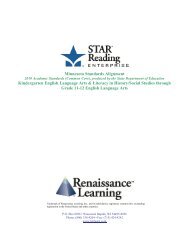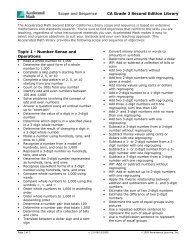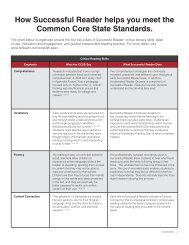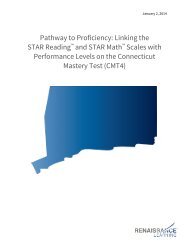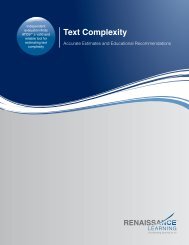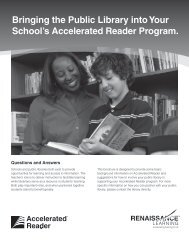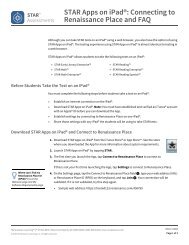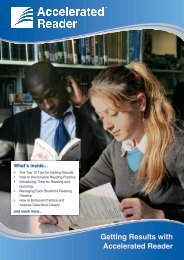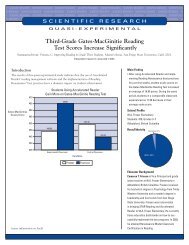Technical Manual - Renaissance Learning
Technical Manual - Renaissance Learning
Technical Manual - Renaissance Learning
You also want an ePaper? Increase the reach of your titles
YUMPU automatically turns print PDFs into web optimized ePapers that Google loves.
ValidityValidation Research Study ProceduresReliability and measurement precision of the adaptive STAR Early Literacytests.Score distributions by age and grade.Validity of STAR Early Literacy.Appropriateness of the adaptive version of STAR Early Literacy.Teacher reactions to the design of the assessment.Sample CharacteristicsThe Validation Study took place in the Spring of 2001. Although the ValidationStudy sample was targeted to include schools using certain standardized earlyliteracy and reading tests, the participating school districts, specific schools, andindividual students were approximately representative of the US schoolpopulation, in terms of the following three key variables:Geographic Region: Using the categories established by the NationalEducation Association, schools fell into four regions: Northeast, Midwest,Southeast, and West.School System and Per-Grade District Enrollment: Statistics distributed byMDR (2001) identified public and nonpublic schools. Public schools werecategorized into four groups based on their per-grade district enrollment:fewer than 200 students, 200–499 students, 500–1,999 students, and morethan 1,999 students. Socioeconomic Status: Using the Orshansky Indicator from MDR (2001),public schools were categorized based on the proportion of students in thedistrict who fall below the federal poverty level. As a result, schools wereidentified as being either of High, Average, or Low socioeconomic status.(Nonpublic schools were not classified by socioeconomic status, associoeconomic data were not available for them.)These factors provide a sampling frame comprising a 52-cell matrix (4 regionalzones × 4 public school enrollment groups × 3 socioeconomic categories, plus 4regional cells for nonpublic schools). All schools in the US were categorized intoone of the 52 cells, and participation was requested from sufficient numbers ofschools to complete the desired sample. This US sampling frame was used only forreference in the analysis of the Validation Study results; the sample itself wasrecruited principally from among schools that had participated in the CalibrationStudy described in “Core Progress <strong>Learning</strong> Progression for Reading and theCommon Core State Standards” on page 36. In addition to US schools, schools inCanada were also recruited to participate in the Validation Study.In April 2001, the 101 schools that agreed to participate received a version of STAREarly Literacy designed to gather the validation research data. This version of theSTAR Early Literacy<strong>Technical</strong> <strong>Manual</strong>82





